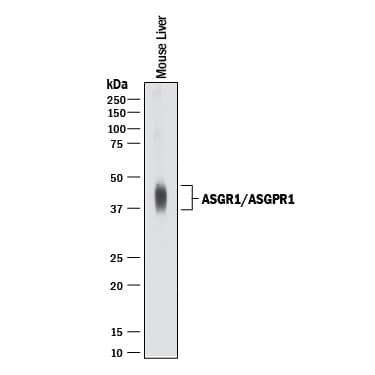Mouse ASGR1/ASGPR1 Antibody
R&D Systems, part of Bio-Techne | Catalog # AF2755

Key Product Details
Species Reactivity
Applications
Label
Antibody Source
Product Specifications
Immunogen
Ser60-Asn284
Accession # Q91Y84
Specificity
Clonality
Host
Isotype
Endotoxin Level
Scientific Data Images for Mouse ASGR1/ASGPR1 Antibody
Detection of Mouse ASGR1/ASGPR1 by Western Blot.
Western blot shows lysate of mouse liver tissue. PVDF membrane was probed with 0.25 µg/mL of Goat Anti-Mouse ASGR1/ASGPR1 Antigen Affinity-purified Polyclonal Antibody (Catalog # AF2755) followed by HRP-conjugated Anti-Goat IgG Secondary Antibody (Catalog # HAF017). A specific band was detected for ASGR1/ASGPR1 at approximately 40-46 kDa (as indicated). This experiment was conducted under reducing conditions and using Immunoblot Buffer Group 1.Applications for Mouse ASGR1/ASGPR1 Antibody
Blockade of Receptor-ligand Interaction
Western Blot
Sample: Mouse liver tissue
Formulation, Preparation, and Storage
Purification
Reconstitution
Formulation
Shipping
Stability & Storage
- 12 months from date of receipt, -20 to -70 °C as supplied.
- 1 month, 2 to 8 °C under sterile conditions after reconstitution.
- 6 months, -20 to -70 °C under sterile conditions after reconstitution.
Background: ASGR1/ASGPR1
The mouse asialoglycoprotein receptor (ASGP-R) is an endocytic recycling receptor that belongs to the long-form subfamily of the C-type/Ca++-dependent lectin family (1-3). It is a complex of two noncovalently-linked subunits, a major 42 kDa glycoprotein (ASGPR1) and a minor 51 kDa glycoprotein (ASGR2). The major mouse ASGP-R subunit, ASGPR1, is synthesized as a 284 amino acid (aa) type II transmembrane (TM) protein that contains a 39 aa cytoplasmic region, a 21 aa TM segment, and a 224 aa extracellular domain (ECD) (4‑6). The ECD contains two important structural regions. The first is a stalk region of 56 aa (aa’s # 59-117) that contributes to noncovalent oligomerization. The second is a 118 aa, carbohydrate-binding, Ca++-dependent C-type lectin domain (aa’s 160-277) that is unusually stabilized by three Ca++ ions (3, 5). There are two potential alternate splice forms for ASGPR1. Both are TM and show a deletion of the C-type lectin domain. One is 113 aa in length and shows a deletion of aa’s # 114-284 (7). The second is 132 aa in length and shows a deletion of aa’s 118-146 and aa’s 162 - 284 (8). Mouse ASGPR1 ECD is 89% and 79% aa identical to the ASGPR1 ECD in rat and human, respectively. The minor mouse ASGP-R subunit, ASGR2, is also a C-type lectin that shares the same structural organization as ASGR-1. It is 301 aa in length and has two 45 kDa and 51 kDa differentially-glycosylated isoforms (4, 6, 9). The ECD of ASGR2 is 50% aa identical to the ECD of ASGPR1. Although ASGPR1 and 2 can be expressed individually, a fully functional and stable ASGP-R requires simultaneous expression of both subunits (10-12). The stoichiometry of a functional ASGP-R is suggested to be either a 2:2, 3:1 or 3:2 ratio of ASGPR1:ASGR2 (13, 14). ASGPR1 is reported to bind Gal (non-reducing), GalNAc, and sialic acid alpha2,6GalNAc (3, 15, 16). This is generally in the context of triantennary or tetraantennary configurations (2).
References
- Stockert, R. J. (1995) Physiol. Rev. 75:591.
- Weigel, P.H. and J.H.N. Yik (2002) Biochim. Biophys. Acta 1572:341.
- Meier, M. et al. (2000) J. Mol. Biol. 300:857.
- Takezawa, R. et al. (1993) Biochim. Biophys. Acta 1172 :220.
- Monroe, R.S. and B.E. Huber (1994) Gene 148:237.
- Sanford, J.P. et al. (1988) DNA 7:721.
- Heath, P. (2005) GenBank Accession # Q5NCV2.
- Heath, P. (2005) GenBank Accession # Q5NCV1.
- Sanford, J.P. and D. Doyle (1990) Biochim. Biophys. Acta 1087:259.
- Braun, J.R. et al. (1996) J. Biol. Chem. 271:21160.
- Ishibashi, S. et al. (1994) J. Biol. Chem. 269:27803.
- Tozawa, R. et al. (2001) J. Biol. Chem. 276:12624.
- Bider, M.D. et al. (1996) J. Biol. Chem. 271:31996.
- Lodish, H. (1991) Trends Biochem. Sci. 16:374.
- Westerlind, U. et al. (2004) Glyconj. J. 21:227.
- Park, E.I. et al. (2005) Proc. Natl. Acad. Sci. USA 102:17125.
Long Name
Alternate Names
Gene Symbol
UniProt
Additional ASGR1/ASGPR1 Products
Product Documents for Mouse ASGR1/ASGPR1 Antibody
Product Specific Notices for Mouse ASGR1/ASGPR1 Antibody
For research use only
